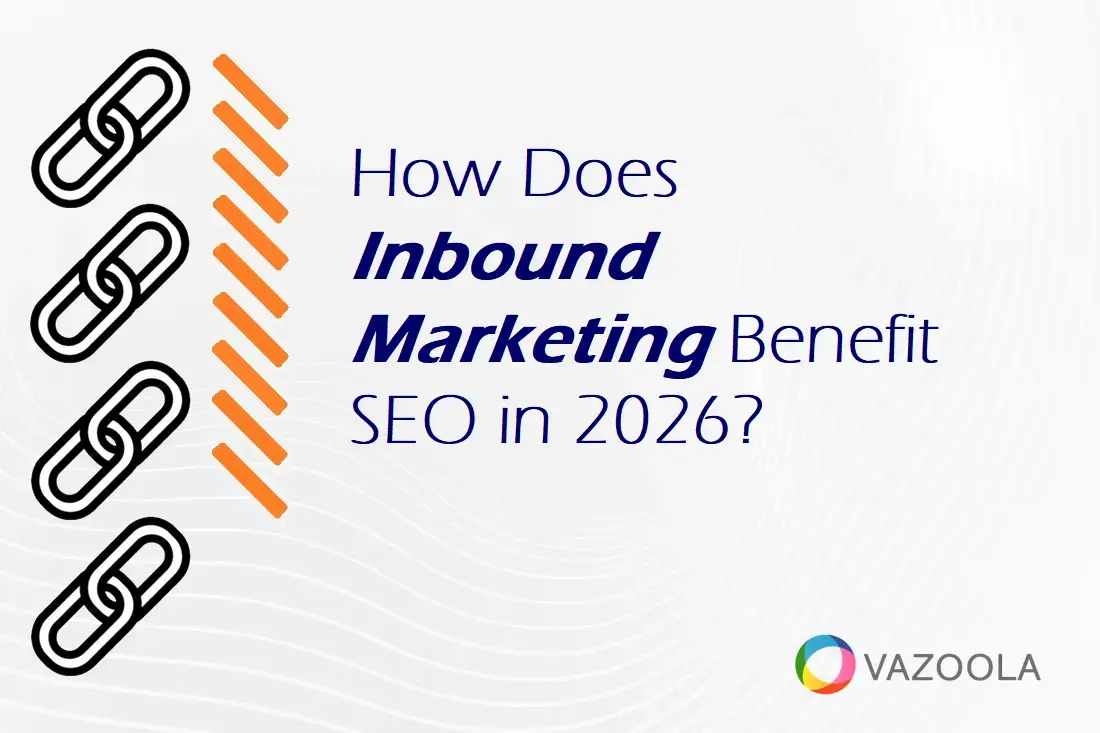How Does Inbound Marketing Benefit SEO in 2026?
Jun 27, 2025
Written by Casey Bjorkdahl

Casey Bjorkdahl is one of the pioneering thought leaders in the SEO community. In 2010, Casey co-founded Vazoola after working for a Digital Marketing Agency for five years in New York City. Vazoola is now one of the fastest growing and most widely recognized SEO marketing firms in the country.

Inbound marketing does a lot more than attract customers. It attracts attention.
From inbound marketing blog posts and videos to white papers and webinars, marketers use inbound tactics to draw users in with helpful, engaging, and relevant content. But while most inbound marketing strategies aim to generate leads, there's another benefit often overlooked: natural backlinks.
Do you know how inbound marketing generates more leads?
High-quality backlinks remain one of the most important ranking factors for SEO in 2025. When inbound marketing is done right, the same content that earns trust can also earn links.
This article focuses on that intersection. Not lead generation. Not product promotion. Just the role inbound marketing plays in helping your content attract links — organically, strategically, and consistently. You’ll also learn how to improve inbound marketing efforts.
Indeed, inbound marketing can help realign your content marketing efforts for better link performance.


Key Takeaways
-
Inbound marketing produces the kind of evergreen, value-driven content that naturally attracts links.
-
Link-worthy formats in 2025 include original research, visual content, and expert roundups.
-
Proactive inbound marketing techniques like HARO outreach, guest content, and content seeding can amplify link success.
-
Avoiding pitfalls like self-promotion and UX issues is key to inbound link generation.
-
Integrating link-building across inbound marketing channels strengthens SEO and brand authority.
Table of Contents
-
How to Work Link Building Into Your Inbound Marketing Strategy
-
Maximize SEO Gains by Aligning Inbound Marketing with Link-Building Strategy
What is Inbound Marketing SEO, Exactly?
What’s the inbound marketing definition, anyway?
Inbound marketing is a long-term strategy that earns attention through helpful content marketing instead of demanding it through advertising. In an SEO context, it serves a dual purpose: driving organic traffic and acquiring high-quality backlinks.
When you publish authoritative blog posts, insightful videos, or free tools, you’re not just helping your audience—you’re giving other creators and sites a reason to link to you. Those links aren’t paid. They aren’t asked for. They’re earned. And that’s what search engines want to see.
Where outbound tactics rely on direct outreach—think paid placements or unsolicited emails—inbound marketing tactics focus on building trust. In 2025, trust translates to traffic. And citations.


Examples of Inbound Marketing
What are the different types of inbound marketing?
Here are a few strategies and other inbound marketing ideas to increase leads. These inbound marketing examples commonly lead to backlinks:
-
- Publishing original survey results on your blog
-
- Creating a how-to video that explains a difficult process
-
- Developing a downloadable checklist or toolkit
-
- Writing a long-form expert roundup
-
- Hosting a free webinar and posting the slides
-
- Designing a compelling infographic for social sharing


These tactics offer genuine value. When executed well, they naturally earn links from inbound marketing blogs, media outlets, and educational sites.

Design sections within your content that naturally attract links—standalone stats, quotable definitions, or mini-charts with embeddable code. Make these assets easy to lift, cite, and attribute by offering embed options or pre-written attribution snippets.
Best Practices for Inbound Marketing and SEO Link Building
What makes content “linkable” in 2025? In the race for the most linkable content, here are a few clear winners.
Original Research and Data
Proprietary studies and industry benchmarks are frequently cited. Use data visualizations to increase link potential.
Visual Assets (Infographics, Charts, Videos)
Visuals stand out in a sea of text. Infographics, charts, and explainer videos get picked up, embedded, and cited often.
Definitive Guides and How-Tos
Deep, evergreen content earns trust and becomes a go-to resource in your niche.
Expert Commentary or Curated Opinions
Content that highlights insights from multiple experts increases your authority—and those featured often link back.
All of these formats align with value-first inbound content. The better your asset, the more likely it is to attract links on its own—and with a little promotion.
You can learn even more about how to create linkable assets and what qualifies as high quality backlinks with these resources.

While inbound is not paid outreach, offering early access or exclusive versions of your content to trusted industry micro-influencers can spark organic mentions, shares, and backlinks—without direct compensation.
Amplifying Your Inbound Marketing Strategy for More Links
Creating link-worthy content is only half the battle if you want to get high domain authority backlinks. Promotion multiplies your chances of success. Here are proven tactics to amplify inbound assets.


Link Prospecting + Content Seeding
For link prospecting and content seeding, identify relevant blogs, forums, and publications where your content would be useful. Share it naturally.
HARO and Expert Quote Outreach
Submit insights to journalists through inbound marketing platforms like Help A Reporter Out (HARO). Earn citations when your quotes are published.
Collaborative Content (Roundups, Interviews, Guest Posts)
Invite others to contribute to your content. Those contributors will likely share and link to it.
Broken Link Reclamation
Search for outdated links in your niche. Offer your content as a current replacement.
Social Sharing and Influencer Networking
Share content in communities, tag collaborators, and build relationships that lead to backlinks.
Inbound content marketing strategies lay the groundwork. These tactics ensure that ground is well-planted. Get even more inbound marketing tips and insights from our inbound marketing guide to link building.

Before promoting a new piece of inbound content, review your internal linking map. Ensure older high-traffic pages link to it contextually. This passes authority internally and boosts crawl priority, increasing the page’s chances of being discovered and linked to externally.
Why SEO Inbound Marketing Sometimes Fails
Not all inbound marketing content succeeds in attracting links. Here are common reasons why:
-
Too Product-Focused: Readers want value, not a pitch. Salesy content rarely gets shared or cited.
-
Not Differentiated: If your guide looks like every other guide, it won’t stand out.
-
Poor UX or Slow Site Speed: A frustrating experience kills trust—and backlinks.
-
No Clear Promotional Plan: Content needs visibility to earn links. Organic reach isn’t enough without distribution.

If these challenges sound familiar, it may be time to consult a marketing agency for help with inbound marketing methodology, inbound strategies, and outreach.

Schedule content launches or outreach during industry conferences, seasonal trends, or regulatory updates. Aligning linkable content with topical momentum makes your outreach more timely—and increases the likelihood of pickups by journalists and bloggers.
How to Work Link Building Into Your Inbound Marketing Plan
Link-building shouldn’t exist in a silo. Here’s how to integrate it into five core areas of inbound marketing:
Content Marketing
What’s your inbound content marketing strategy? Build link acquisition into plans for your inbound marketing process. Use formats like research, roundups, and visuals intentionally.
SEO
Optimize your content for ranking, but also for referencing. Include stats, quotes, and valuable resources that others will want to cite.
Social Media Marketing
Use social posts to promote your content and attract engagement. Tag collaborators and share in niche groups when conducting inbound marketing social media.
Email Marketing
Promote linkable content to your list. Ask for feedback. Encourage sharing.
Lead Generation and Nurturing
Include high-value content in your lead inbound marketing funnels. The better the asset, the more likely it is to be referenced elsewhere.
Each area supports the others. When they work together, you don’t just attract traffic—you attract trust.

Design infographics and charts with subtle but visible branding and URL references. When these visuals are reused without a link, you can reach out for proper credit—and often earn a follow-up backlink with minimal friction.
Maximize SEO Gains by Aligning Inbound Marketing with Link-Building Strategy
An inbound marketing campaign helps brands show up, stand out, and stay relevant. But its impact goes beyond customer acquisition. Done right, it builds SEO power by earning citations from trusted sources.
To recap:
-
Publish link-worthy assets like research, guides, and visuals.
-
Promote those assets through outreach and smart distribution.
-
Avoid pitfalls like slow sites, poor UX, or overly promotional messaging.
-
Integrate link-building across every inbound channel.
Backlinks are earned, not bought. Let your inbound marketing tools do the heavy lifting.
And if your content is no longer earning the attention—or links—it once did, it might be time for a change in your inbound marketing campaigns. Learn more about why your content marketing needs a refresh and how to get started.

Use natural language processing tools (like Link Context or Clearscope integrations) to assess the sentiment and placement of your backlinks. Aim to keep links surrounded by positive, relevant context—otherwise, they may carry less weight in Google’s semantic evaluation models.



